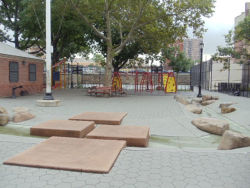Webster Playground
Webster Playground
This playground is named for nearby Webster Avenue. The avenue opened to East 184th Street in 1879, and in 1882 the avenue was extended to Fordham Road.
There are three noted figures for whom the avenue may have been named. Joseph Outen Bogart Webster (b.1919) surveyed the road, and Albert L. Webster (1859-1930) worked for New York City’s Department of Public Works during the road’s lengthening. It is also possible that the name is not local and honors U.S. lawyer and statesman Daniel Webster (1782-1852).
On May 23, 1870, the surveyor Joseph O.B. Webster began 40 years of work as a topographical engineer for New York City. He worked as a consultant for the Borough President of Manhattan, surveying and laying out new streets. Webster also belonged to the Sons of the American Revolution, the organization for male descendants of those who fought in the Revolutionary War (1776-1783).
Department of Public Works employee Albert L. Webster graduated from Yale in 1879. He worked for the U.S. Geological Survey on a project to map the western U.S. and designed a famous water tower in Warsaw, Poland. When he returned to the U.S., Webster studied at John Hopkins University. Later moving to New York to work as a sanitation engineer, Albert Webster served as a consultant for the construction of Grand Central Station (which was replaced in 1910 with the current terminal), and the New York Public Library as well as several other well-known City buildings. Webster also was a member of the American Society of Civil Engineers and published a collection of children’s stories and pictures called, “Caleb,” which he had initially put together for his own children.
Dartmouth-educated Daniel Webster served as a U.S. Senator from Massachusetts (1827-41, 1850-52) and Secretary of State (1841-43, 1850-52). He negotiated the Webster-Ashburton Treaty, which resolved a boundary dispute with England over Maine and New Brunswick and may have prevented war. Webster’s legal arguments before the Supreme Court became integrated into important cases, including Dartmouth College v. Woodward, which established the sanctity of contracts. Despite his large income, Webster always managed to find himself in debt, mainly because of spending habits and unsuccessful land speculation.
Parks Commissioner Robert Moses (1888-1981) submitted plans for the construction of the playground and improvement of this lot on March 27, 1952, after competing with the Department of Health for the property. The Department of Health hoped to build the Fordham Health Center on this site. Instead, the two sides reached an agreement to share the property. On October 23, 1953, a local law named this property Webster Memorial Playground. On July 28, 1953 the playground opened. The Webster Memorial Post of the American Legion, number 1799, dedicated a plaque on February 22, 1954 honoring those who died in World War II (1939-1945).
Webster Playground is situated slightly lower than street level. It features swings, timber form play equipment with safety surfacing, a slide, pin oaks (Quercus palustris), a public restroom, and two full basketball courts. There are also benches and picnic tables. Mayor Rudolph Giuliani funded $16,971 of improvements completed on July 12, 1999.
Check out your park's Vital Signs
Clean & Safe
Green & Resilient
Empowered & Engaged Users
Share your feedback or learn more about how this park is part of a
Vital Park System





